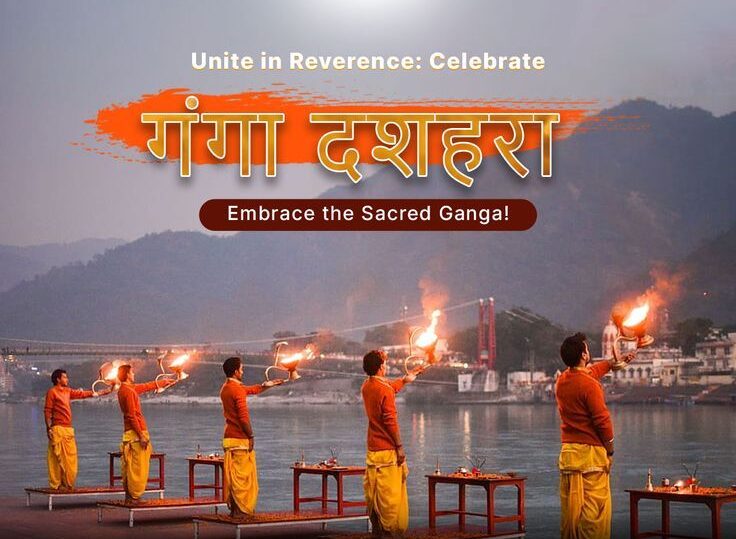🏞️ Ganga Dussehra – A Sacred Flow of Devotion, Culture, and Cleansing
Ganga Dussehra, one of the most spiritually significant Hindu festivals, marks the descent of the sacred River Ganga from the heavens to Earth. Celebrated with immense devotion and grandeur across northern India, especially in Uttarakhand, Uttar Pradesh, Bihar, and West Bengal, it blends mythological reverence with environmental awareness and social unity.
- 📜 History of Ganga Dussehra
- 🕰️ Timeline of Ganga Dussehra and Its Observance
- 🔟 Divine Facts About Ganga Dussehra
- ❓ Frequently Asked Questions (FAQs)
- Q1. When is Ganga Dussehra celebrated?
- Q2. What is the spiritual significance of this day?
- Q3. What rituals are performed on Ganga Dussehra?
- Q4. Is Ganga Dussehra a public holiday?
- Q5. What is the difference between Ganga Dussehra and Ganga Saptami?
- 🕯️ Observance and Rituals
- ✨ Significance of Ganga Dussehra in Our Life
- 1. Spiritual Purification
- 2. Cultural Preservation
- 3. Environmental Consciousness
- 4. Social Unity
- 5. Health Benefits
- 🕊️ Wishing Messages for Ganga Dussehra
- 🌍 Daily Life Impact of Ganga Dussehra
- 🧭 Importance in Society
- 📌 Important Points at a Glance
- 🪙 Conclusion: A Flow of Faith, Culture, and Responsibility
The day is observed on the Dashami (10th day) of the waxing moon in the month of Jyeshtha (May–June), typically falling 10 days before the summer solstice. Pilgrims gather at ghats (riverbanks), offer prayers, take holy dips, and seek liberation from their sins.
This article unveils Ganga Dussehra’s 1200+ year legacy, real-world significance, human emotions behind it, and its powerful spiritual impact.
📜 History of Ganga Dussehra
The origins of Ganga Dussehra are deeply rooted in Hindu mythology, primarily from the Skanda Purana, Padma Purana, and Ramayana.
According to legend, King Bhagiratha, a descendant of the Suryavansha dynasty, performed thousands of years of penance to bring the celestial river Ganga to Earth to purify the souls of his ancestors who were reduced to ashes due to Sage Kapila’s curse.
Moved by his devotion, Lord Brahma granted the wish but instructed Bhagiratha to appease Lord Shiva, who alone could bear the force of Ganga’s fall. Shiva agreed and caught Ganga in his matted locks, letting her flow gently onto Earth. This event is commemorated as Ganga Dussehra—a divine union of compassion, penance, and cleansing.
🕰️ Timeline of Ganga Dussehra and Its Observance
| Period | Event |
|---|---|
| Vedic Era | Ganga is first mentioned in Rigveda as a sacred river. |
| Ancient Times | Bhagiratha’s penance story gains prominence in Purāṇic texts. |
| Medieval Period | Pilgrimage centers along Ganga (Haridwar, Prayagraj, Varanasi) develop further. |
| 19th Century | British rule documents cultural and health significance of river Ganga. |
| Modern Day | Festival observed with mass pilgrimages, environmental drives, and heritage celebrations. |
🔟 Divine Facts About Ganga Dussehra
🔱 Ganga Dussehra spans 10 days, symbolizing 10 forms of sin being washed away.
🛕 The river Ganga is worshipped as a goddess (Ganga Devi) in Hinduism.
🌊 It’s believed that taking a dip on Ganga Dussehra washes away lifetimes of sins.
🙏 The festival is especially grand in Haridwar, Varanasi, Rishikesh, and Prayagraj.
🕉️ Devotees chant Ganga Sahasranam (1000 names of Ganga) on this day.
🌞 The holy dip taken at sunrise is said to be most spiritually rewarding.
🌿 Devotees float leaves with diyas, flowers, and incense as offerings.
📿 The Ganga is called Tripathaga – as she flows in Swarga (heaven), Bhumi (earth), and Pātāla (netherworld).
🌎 Recognized globally, the Ganga is part of UNESCO Heritage and global water sustainability discussions.
♻️ Environmental campaigns are now integral to modern observances of Ganga Dussehra.
❓ Frequently Asked Questions (FAQs)
Q1. When is Ganga Dussehra celebrated?
It is observed on the Dashami (10th day) of the waxing moon in Jyeshtha month (May–June).
Q2. What is the spiritual significance of this day?
Bathing in Ganga on this day is said to cleanse sins, bring inner peace, and lead to moksha (liberation).
Q3. What rituals are performed on Ganga Dussehra?
Rituals include taking a holy dip, offering aarti, lighting lamps, chanting mantras, and donating to the needy.
Q4. Is Ganga Dussehra a public holiday?
It is not a national holiday but is widely observed with religious holidays in Uttar Pradesh, Uttarakhand, and Bihar.
Q5. What is the difference between Ganga Dussehra and Ganga Saptami?
Ganga Saptami marks Ganga’s rebirth while Dussehra marks her descent to Earth.
🕯️ Observance and Rituals
🌊 Holy Dip
Devotees bathe in the Ganga or other sacred rivers at sunrise, chanting “Har Har Gange”.
🪔 Ganga Aarti
Performed during sunrise and sunset with incense, lamps, conch shells, and sacred chants.
🎁 Charity
Offering food, clothes, water, and donations to the poor is considered highly auspicious.
🪶 Environmental Efforts
Modern observance includes river cleanups, plastic bans, and eco-awareness rallies.
🪷 Pujas and Mantras
Devotees recite Ganga Stotram, Bhagirathi Ashtak, and Ganga Sahasranama.
✨ Significance of Ganga Dussehra in Our Life
1. Spiritual Purification
The belief in cleansing sins is not just religious—it encourages inner reflection and repentance.
2. Cultural Preservation
The festival reinforces intergenerational transmission of Hindu rituals, folklore, and art.
3. Environmental Consciousness
Emphasis on keeping rivers clean bridges spiritual reverence with eco-responsibility.
4. Social Unity
Brings together diverse communities, saints, and common people under one cause—reverence for life-giving water.
5. Health Benefits
Bathing early morning in flowing river water is believed to boost immunity and mental peace.
🕊️ Wishing Messages for Ganga Dussehra
🌸 “May Maa Ganga cleanse your soul, bless your family, and fill your life with positivity and peace. Happy Ganga Dussehra!”
🌊 “Wishing you and your loved ones the divine blessings of Ganga Devi—purity, strength, and serenity. Har Har Gange!”
🌞 “On this auspicious Ganga Dussehra, let us vow to keep our rivers clean and our hearts purer.”
🙏 “May the sacred flow of Ganga wash away all your worries and bring eternal peace.”
🌍 Daily Life Impact of Ganga Dussehra
Ganga Dussehra impacts modern life in profound ways:
Reinforces respect for water conservation.
Encourages spiritual reflection and mental wellness.
Promotes eco-conscious traditions over consumerist practices.
Inspires volunteerism and seva (selfless service).
Revives local economies through tourism, artisanship, and pilgrimage.
🧭 Importance in Society
✅ Cultural Identity
The Ganga is more than a river—she is a mother, a goddess, and a nurturer in Indian life and thought.
✅ Ecological Sensitivity
Ganga Dussehra sheds light on river pollution, biodiversity threats, and the urgency for river rejuvenation.
✅ Economic Impact
Thousands of livelihoods—priests, flower sellers, boatmen—depend on river-based pilgrimage.
✅ Political Awareness
It inspires state and national efforts like Namami Gange, aiming for clean and sustainable rivers.
📌 Important Points at a Glance
📆 Celebrated in May–June (Jyeshtha Shukla Dashami)
🌊 Commemorates descent of Ganga to Earth
🛕 Major celebrations in Haridwar, Varanasi, Prayagraj
🕉️ Sacred bathing, aarti, mantra chanting, and charity
🌿 Environmentally significant, now tied to river-cleanup efforts
🙏 Connects mythology, spirituality, health, and society
🪙 Conclusion: A Flow of Faith, Culture, and Responsibility
Ganga Dussehra is not just a Hindu ritual—it’s a profound spiritual, ecological, and societal event that binds millions in a common thread of reverence, responsibility, and renewal.
As we offer flowers to the sacred river, let’s also offer our efforts to protect her purity, preserve our culture, and pass down her teachings to future generations.
May the eternal Ganga forever flow through our land—and our hearts.
Har Har Gange!








